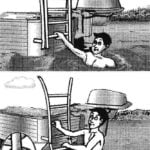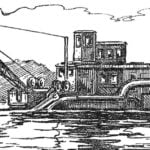If we assume that the fundamental issues we have decided, then proceed directly to the design of the new model. The only thing that I would like to note: for such a high-speed important to be able to distinguish a fir wood from a pine or even a lime tree from ASP as well as confident enough to navigate in terms of the densities of these materials.
So: the main detail — the case of aerolister. He’s represented… one beam of light spruce or aspen! I guess some would call this decision exaggerated, especially if you get acquainted with the following parts. But… read again all that is written above, and try to take a similar approach. Then you will be able to absolutely other eyes to watch and evaluate the work of other designers.
The total volume of timber of the main body is equal to 900 cm3, when the real density of light spruce or aspen 0.3 g/cm3 will give a weight, equal to 270 g. For a pair of floats, these values are respectively 260 cm3 and 78 g. Add weight to the summary: the engine with a propeller and spinner — 200 g, telefonerna stabilizer (neoplachennom version) — 55 g, pylon fairing with the power plant and fuel tank — about 100 g and epoxy resin for the Assembly of coatings for exterior— 97g (a lot!). Total is exactly 800 grams! Is the total displacement of body parts 1170 g.
We would like to note: if you are lucky enough to find a light durable wood required density, the thickness of the blanks for the hull and floats to reduce in half (30 mm case and 17 mm for floats). The total displacement will be equal to 780 g, but the mass of aerolizer reduced. New weight summary would look like this: case—180 g, floats — 52, engine — 200 lightweight reduced stabilizer of three layers mm plywood — 34, pylon fairing and the tank 100 g and leitlinie materials — 54 g. the Finished model will weigh Assembly 620 g.
Wood density-0.5 g/CM1 is estimated without any knowledge of its properties as “severe”; therefore, for completeness we present only the weight of the model in shown in the drawings, when the density of the blanks for the hull and floats 0.4 g/cm”, it is equal to 916 g (with integral stabilizer and a large ink consumption). As you can see, even with fairly heavy material airboat with that said is within the rules.
After meeting with a record simple model you might seem somewhat over-engineered pole-alterately part. Perhaps you are lucky enough to design and more simple. The only thing I would recommend— do not use even a little bit serious Junior models the simplest plate-pole split at the crankcase. She bears the signs of “children’s” equipment not originally designed for the achievement of sports results. In addition, nasekomojadny motor with tank, it turns out, has the wind resistance equal to the resistance of the rest of the model aerolizer.
On the proposed high-speed used motor KMD-2,5 rotated 90′ Zolotnik with the rear wall of the housing and chrome-plated piston. About the benefits of the turn of the wall, we learned in one of the model aircraft publications in the “M-K”. Indeed, improved engine over speed with light propellers: he has no signs of overload, more power and a few quieter exhaust sound. Nutrition carb — under pressure taken from the crankcase through a valve which is screwed the upper left mounting screw of the wall (the position of the cylinder in this orientation is vertically upwards). Through the slot of the screw in the crankcase overlevelse inclined hole 0 1.5 mm with access to podporchennuyu area.
V. VICTORY, head of the society
Recommend to read
 UNDERWATER, FOLDING
UNDERWATER, FOLDING
Now, many are addicted to power boats and water skiing. But most of these boats designed for landing with the pier: the man in the water, they can get complicated. However, it is easy to... UNDERWATER DIGGERS
UNDERWATER DIGGERS
Upcoming XXV Congress of the CPSU will summarize the implementation of the ninth five-year development plan of national economy and chart a new rollers of Communist construction in our...
 Today we offer young modelers rather unusual development of high-speed cord models apropriada. Novelty design in unusual approach to design. Perhaps this is an approach based on the full (but competent at the same time, taking into account all the important factors) simplification, truly perfect. For good reason, among these designers, there is a widespread saying: “a Difficult decision can find any, and to solve the task a minimum number of simple parts and assemblies — only genius.”
Today we offer young modelers rather unusual development of high-speed cord models apropriada. Novelty design in unusual approach to design. Perhaps this is an approach based on the full (but competent at the same time, taking into account all the important factors) simplification, truly perfect. For good reason, among these designers, there is a widespread saying: “a Difficult decision can find any, and to solve the task a minimum number of simple parts and assemblies — only genius.”